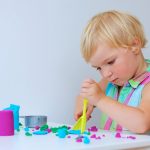 At this stage, little ones are gaining more control of their bodies. They may be able to walk down stairs without support, and leading with one foot (if they don’t have stairs at home this may take longer). They can jump higher with both feet, and thanks to increased perceptual awareness, they also show more control by handling fragile objects more carefully or interacting with the family pet more gently.
At this stage, little ones are gaining more control of their bodies. They may be able to walk down stairs without support, and leading with one foot (if they don’t have stairs at home this may take longer). They can jump higher with both feet, and thanks to increased perceptual awareness, they also show more control by handling fragile objects more carefully or interacting with the family pet more gently.
They have more fine motor control, too, and begin to scribble with more detail. They may also start to scribble with intention to communicate something, which is a huge cognitive leap because it requires planning, remembering, and executing a goal.
Other cognitive developments include using their own name when they see themselves in the mirror, an increased ability to remember past events, and an emerging ability to compare size, shape or color (for instance saying “red truck” when comparing it to other toy vehicles that are different colors).
When little ones speak, they may invent cute ways to express something when they don’t know the correct vocabulary, such as calling a squirrel a “tree mouse”. Other language quirks include using the same word for similar things (calling all feline animals “kitty,” for example). Another exciting development is being able “read” familiar environmental print. For example, when driving past their favorite ice cream shop, they see the sign and say: “Ice cream!”
They can now pull down their own pants (elastic waist), and pitch in with chores like feeding the family pet or setting the table.
Social-emotional development continues, too, as little ones express emotions in a variety of ways (combining facial expressions, gestures, sounds and words).
Remember that children are delightfully unique and some of these milestones will happen before or after this month.








